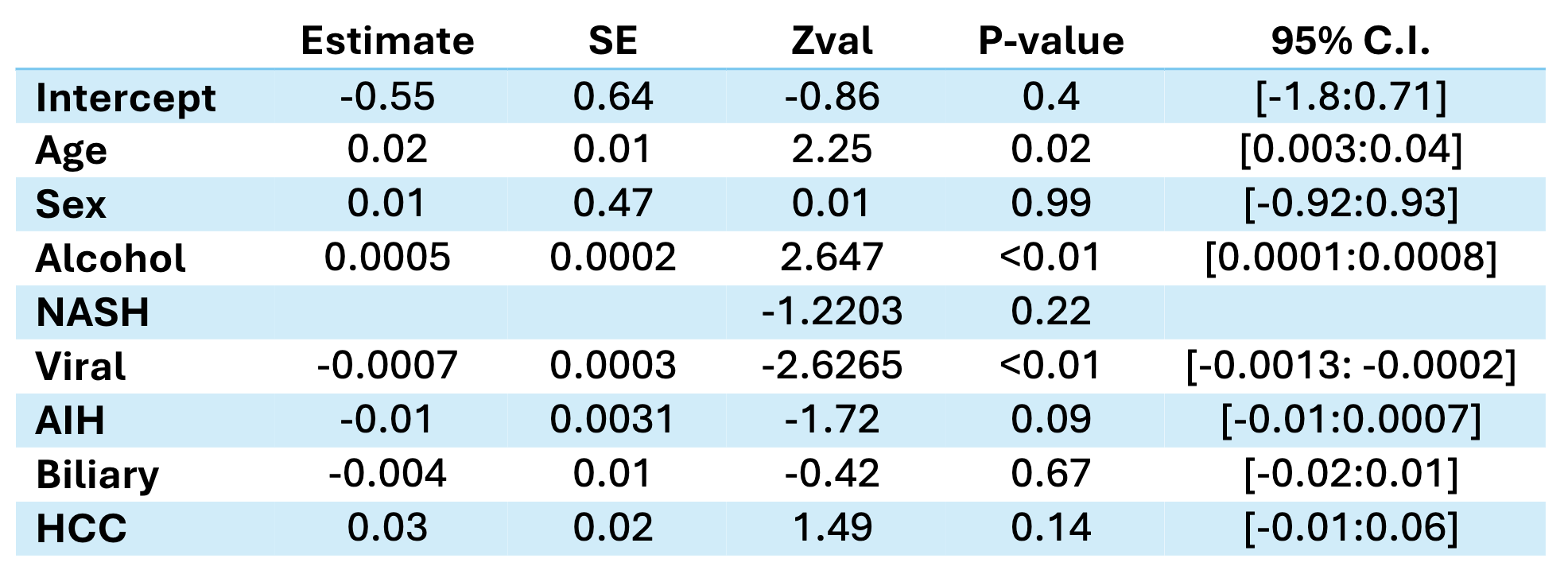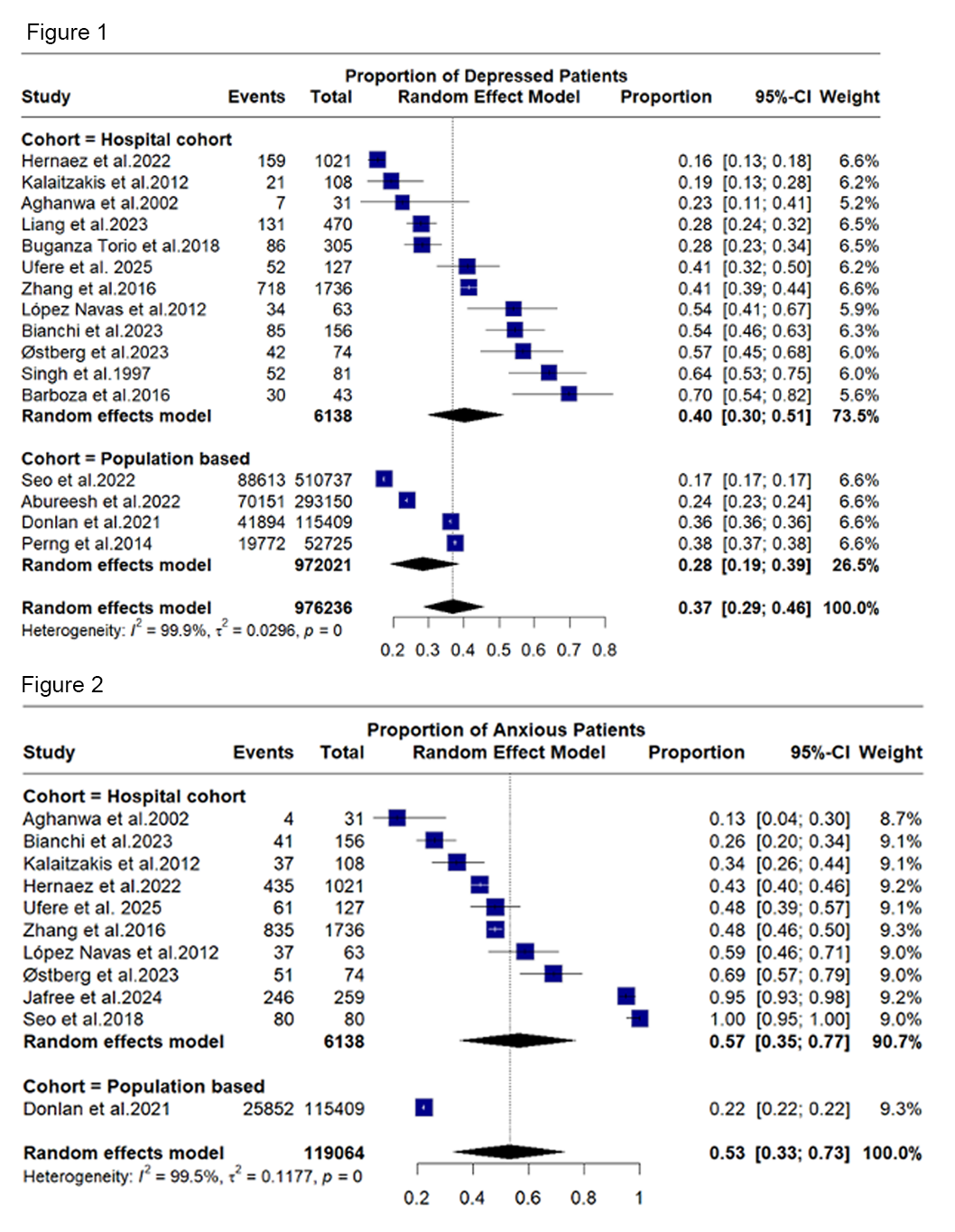Monday Poster Session
Category: Liver
P3795 - Global Prevalence of Anxiety and Depression in Patients With Liver Cirrhosis: A Systematic Review and Meta-Analysis
Monday, October 27, 2025
10:30 AM - 4:00 PM PDT
Location: Exhibit Hall

Omar Abureesh, MD (he/him/his)
Staten Island University Hospital, Northwell Health
Staten Island, NY
Presenting Author(s)
Omar Abureesh, MD, Araek Al-shraideh, MD, Joelle Sleiman, MD, Liliane Deeb, MD
Staten Island University Hospital, Northwell Health, Staten Island, NY
Introduction: Patient with liver cirrhosis have a heightened prevalence of anxiety and depression linked to decreased health-related quality of life and poor treatment outcomes. This study aims to examine the current evidence of anxiety and/or depression prevalence in cirrhotic patients.
Methods: PubMed/MEDLINE, Embase, and Cochrane databases were searched for original articles from inception till December 2024. Included articles investigated the prevalence of depression or anxiety in liver cirrhosis of all etiologies. All analyses were conducted on R using the “meta” package. This review was conducted per the preferred reporting Items for systematic reviews and meta-analyses guidelines.
Results: Twenty-three worldwide articles describing 979113 patients were included: 11 cohort studies and 12 cross-sectional studies. The majority were hospital-based studies (82.6%) and 4 studies were population-based. The mean age was 57.1 ±13.4 years, and males comprised 57% of the total number of patients.
Depression
Subgroup analysis shown in figure 1 illustrated an overall proportion of depression of 0.37 [95% CI: 0.29-0.46, p=0.1] in cirrhotic patients. In hospital-based studies, the proportion was 0.4 [95% CI: 0.3-0.51] versus 0.28 [95% CI: 0.19-0.39] in population-based studies.
High heterogeneity was observed, (I2 = 99.9%), and sensitivity analysis failed to identify a particular source of heterogeneity. Therefore, it was deemed as natural data heterogeneity. Meta-regression was performed to assess the ability of demographic or etiological factors to predict depression in cirrhotic patients. Age, viral and alcohol related etiologies significantly predicted depression incidence; as illustrated in table 1.
Anxiety
Anxiety proportions were assessed using meta-analysis of proportions. Among studies reporting anxiety incidences, the overall proportion was 0.53 [95% C.I. 0.33-0. 73], with significant subgroup differences (p< 0.01). The high proportion was mainly due to hospital-based cohorts' anxiety incidence that was 0.57 [95% C.I. 0.35-0.77] as shown in figure 2. Meta-regression of suspected predictors of anxiety was conducted with no significant results.
Discussion: Our analysis revealed that nearly one in 3 cirrhotic patients experience depression, while close to half suffer from anxiety. Additional prospective studies are warranted to validate these results. Standardized screening for mental health in cirrhosis is crucial for early identification or intervention and should be adopted globally.

Figure: Figure 1: Forest plot of the proportion of Depression in the included studies.
Figure 2: Forest plot of the proportion of Anxiety in the included studies.

Figure: Table 1: Meta-regression of demographic and etiological factors associated with depression in liver cirrhosis.
Disclosures:
Omar Abureesh indicated no relevant financial relationships.
Araek Al-shraideh indicated no relevant financial relationships.
Joelle Sleiman indicated no relevant financial relationships.
Liliane Deeb indicated no relevant financial relationships.
Omar Abureesh, MD, Araek Al-shraideh, MD, Joelle Sleiman, MD, Liliane Deeb, MD. P3795 - Global Prevalence of Anxiety and Depression in Patients With Liver Cirrhosis: A Systematic Review and Meta-Analysis, ACG 2025 Annual Scientific Meeting Abstracts. Phoenix, AZ: American College of Gastroenterology.
Staten Island University Hospital, Northwell Health, Staten Island, NY
Introduction: Patient with liver cirrhosis have a heightened prevalence of anxiety and depression linked to decreased health-related quality of life and poor treatment outcomes. This study aims to examine the current evidence of anxiety and/or depression prevalence in cirrhotic patients.
Methods: PubMed/MEDLINE, Embase, and Cochrane databases were searched for original articles from inception till December 2024. Included articles investigated the prevalence of depression or anxiety in liver cirrhosis of all etiologies. All analyses were conducted on R using the “meta” package. This review was conducted per the preferred reporting Items for systematic reviews and meta-analyses guidelines.
Results: Twenty-three worldwide articles describing 979113 patients were included: 11 cohort studies and 12 cross-sectional studies. The majority were hospital-based studies (82.6%) and 4 studies were population-based. The mean age was 57.1 ±13.4 years, and males comprised 57% of the total number of patients.
Depression
Subgroup analysis shown in figure 1 illustrated an overall proportion of depression of 0.37 [95% CI: 0.29-0.46, p=0.1] in cirrhotic patients. In hospital-based studies, the proportion was 0.4 [95% CI: 0.3-0.51] versus 0.28 [95% CI: 0.19-0.39] in population-based studies.
High heterogeneity was observed, (I2 = 99.9%), and sensitivity analysis failed to identify a particular source of heterogeneity. Therefore, it was deemed as natural data heterogeneity. Meta-regression was performed to assess the ability of demographic or etiological factors to predict depression in cirrhotic patients. Age, viral and alcohol related etiologies significantly predicted depression incidence; as illustrated in table 1.
Anxiety
Anxiety proportions were assessed using meta-analysis of proportions. Among studies reporting anxiety incidences, the overall proportion was 0.53 [95% C.I. 0.33-0. 73], with significant subgroup differences (p< 0.01). The high proportion was mainly due to hospital-based cohorts' anxiety incidence that was 0.57 [95% C.I. 0.35-0.77] as shown in figure 2. Meta-regression of suspected predictors of anxiety was conducted with no significant results.
Discussion: Our analysis revealed that nearly one in 3 cirrhotic patients experience depression, while close to half suffer from anxiety. Additional prospective studies are warranted to validate these results. Standardized screening for mental health in cirrhosis is crucial for early identification or intervention and should be adopted globally.

Figure: Figure 1: Forest plot of the proportion of Depression in the included studies.
Figure 2: Forest plot of the proportion of Anxiety in the included studies.

Figure: Table 1: Meta-regression of demographic and etiological factors associated with depression in liver cirrhosis.
Disclosures:
Omar Abureesh indicated no relevant financial relationships.
Araek Al-shraideh indicated no relevant financial relationships.
Joelle Sleiman indicated no relevant financial relationships.
Liliane Deeb indicated no relevant financial relationships.
Omar Abureesh, MD, Araek Al-shraideh, MD, Joelle Sleiman, MD, Liliane Deeb, MD. P3795 - Global Prevalence of Anxiety and Depression in Patients With Liver Cirrhosis: A Systematic Review and Meta-Analysis, ACG 2025 Annual Scientific Meeting Abstracts. Phoenix, AZ: American College of Gastroenterology.
